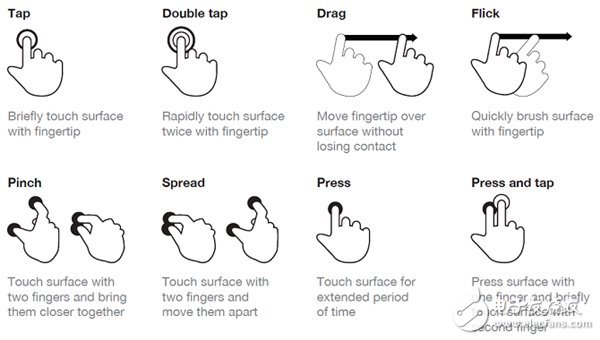In order to better highlight the screen content, the world's smartphone screens are taking a simple design route. No matter whether it is a physical or virtual key, it is no longer seen, and the chaotic screen is being abandoned. That is to say, gestures - scrolling, swiping, clicking, pinching and dialing - are becoming the mainstream way of mobile interaction, and voice and facial expression control are also emerging.

The types of gestures are increasing, but the chances of using many gestures are not large, and watching this smartphone control gesture set, the gestures inside are so large that the average person is surprised.

The famous cognitive scientist Don Norman (author of The Design of Everyday Things) is likely to say that if people don't use the gestures provided by smartphones, and smartphones are for people – we should think of mobile phones. The design is flawed. (Because of the flaws in human beings as a whole, we can't do anything about it).
So, what kind of gestures can stand out in the public gestures, precipitate in time, and at the same time be accepted by users in a multicultural context? If you want to design a gesture that is as popular as "pull-down refresh, kneading zoom", UX (user experience) designers, researchers, and engineers must consider many factors, including human weaknesses.
Design screen touch gesture
The phone has a range of sensors to implement a variety of input behaviors: touch sensors, optical sensors, acceleration sensors, and image sensors. For touch gestures, the phone determines what action to perform by recognizing the position, motion trajectory, speed, and angle of the user's hand. Since people are not as standardized as mobile phones, these gestures don't have to be consistent but there should be a rough standard.
To guide people to use their phones, designers use relevant visual, audible and tactile cues. For example, there is often a signal at the corner of the screen that prompts the user to perform an action in order to obtain further information. The positive and negative feedback given by the phone - the buzz, the loading symbols and the operating status all affect the user experience.
Yaro Brock, co-founder and senior UX researcher at Cookie Jar UX, said that mobile phones should rely on prompts to guide people through gestures step by step. But the problem is that human patience is limited. If you learn slowly, we will quickly turn off the annoying tips, and the study will be gone.
The way gesture gestures are designed depends on how well UX designers and engineers understand the user. They tend to test against the average person and, on this basis, correct the unreasonable gestures to make them more in line with the general user habits.
In fact, we are often in a state where both hands are not enough, and the mobile phone has to operate with one hand. This largely limits the types of gestures that users can use. Our patience in learning gestures is really limited. T-Mobile senior UX manager David Winkler said: "If users feel too difficult or fail repeatedly, people will give up."
What is the easy-to-use gesture?
The best gestures are simple, and the two support one-handed operation. They are as popular as Loren Brichter's patented "pull-down refresh". Or as simple as Flipboard's flipping action. Here are some of the features that good gestures have.
· Easy to use. Not only is the action simple, but it can also be operated with one hand on a crowded subway.
· Easy to remember. One of the gestures should be easy to remember, and the other should be remembered.
·natural. That is to say, the gesture should follow the natural habits and consciousness of the person on the one hand, and the operation to be produced by the gesture on the other hand.
·practical. Gestures are designed to make users feel comfortable. Few users are willing to click twice to see what they want to see, which will make them feel troublesome.
· A pleasant experience. Winkler thinks that good gestures will have a magical feeling. UX is always unknown and difficult to say. But this is just a manifestation of our understanding and enjoyment of technology. Brock said: "We live in an era of things, to a certain extent, they constitute the meaning of our lives. Like a pair of shoes or jeans, although worn, but comfortable."
Future gesture
More gestures will be generated in the future, but most will be abandoned. People can remember or want to be a reporter's gesture is limited. In the long run, gestures are gradually integrated with sensors, location-transmitted information, and other personal information.
The Galaxy S4 uses eye tracking technology - when the gaze moves to the bottom of the page, the page scrolls, and Moto X is ready to go. The Google Now app can give users a card-like reminder based on your location and personal schedule changes. Flutter and the like control the phone through facial expressions and no touch gestures, but it is not convenient to use such large gestures in public.
These may not be called gestures, but this is generated by the user's needs - who makes the gesture itself not perfect. Winkler said: "In the future, gestures will become more and more understandable and cater to the needs of users in specific scenarios, and become smarter." In other words, this means that we only need to remember very few gestures, and it can be a bit stupid. It is.
Elegant and charming geometric lines, quiet and simple colors, let the public appreciate the charm of the new simple chandelier
Passion for life needs to have a good home, and the home is where it is.
Home is the most relaxing place to relax.
New products will make your eyes shine.
new style models,new style hanging lamp,new style models pendant lamp
Monike lighting , https://www.monikelight.com